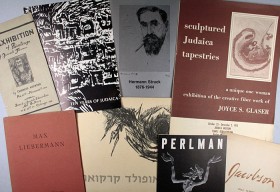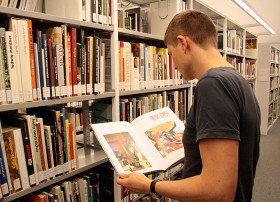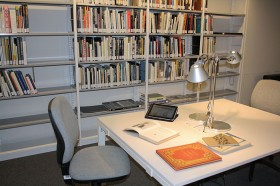
Gray literature held by the library, Gross Family Collection © Jewish Museum Berlin, Photo: Lea Weik
The library of the Jewish Museum Berlin is growing day by day. Since early 2014, this has been particularly noticeable in the Jewish visual and applied arts section, which currently stocks about 10,000 media objects (books, journals, non-book media, etc.). As part of the framework of a project funded by the DFG (German Research Foundation), which I have been working on for the past year, our team has had the opportunity to make essential acquisitions and to close existing gaps in this area. Further expansion is planned—and will take us another big step towards our goal of establishing a research library for Jewish art and cultural history.
Before the first Jewish visual and applied arts publications arrived at the library, there were many tasks to be performed: first and foremost, to settle the question, “What do we want to collect?” In consultation with the museum curators we defined the focal points of our acquisition policy. For instance, we decided to collect German titles on topics or people from German-speaking countries as comprehensively as possible. When it comes to publications on Jewish art from other countries, however, especially from the non-European ones, we decided to generally collect only standard works of reference. Similarly with Israeli art we will acquire only selected literature on certain topics and artists. This is due to the fact that the DFG Special Collection on Israel in the University Library of Frankfurt am Main covers the field extensively.
My current priority is to find monographs on artists whose work is either held in the collection of the Jewish Museum Berlin or has been presented by the Museum in past exhibitions.

User of the library’s Jewish Art section in the Reading Room of the Academy of the Jewish Museum Berlin
© Jewish Museum Berlin, Photo: Lea Weik
In order to ensure that our collection will remain easily accessible to a broad public even after the planned acquisition of a further 2,000 items, we created a better, more highly differentiated classification system right at the start of the project. Searching for a specific publication among the many diverse subject areas in our library is now easier than ever.
My work essentially consists of trawling specialized bibliographies and library catalogs in order to identify relevant literature. Our curators are another vital source of important tips and leads for me, because they regularly come across works of interest in the course of their broad-ranging research into artifacts, topics and individuals.
This is why since the start of the project we have been able to select over 1,000 titles, enter them into our catalog, and in most cases acquire them as well. We mostly find books on the Internet. Since most of them are not available in regular bookshops, our searches are not always successful. Fortune does smile upon us occasionally, however. For example, in my very first month on the job I happened to meet an American antiquarian who had contacted the Museum on other business, and learned about our project that way. It sparked his interest immediately and he compiled a comprehensive list of possible acquisitions from his collection for me, all works on Jewish art. This allowed me to acquire, rapidly and without further ado, quite a number of rare books we had priviously been lacking.
A particular challenge in this second year of the project will be to acquire so-called gray literature, or publications that were never published commercially and are hard to find. Such material is often published in small quantities by small institutions, galleries and local initiatives. It may well be the only source of information available for the documentation of minor Jewish exhibition and museum projects and is therefore of great interest to us.
Once books arrive, they have to be assigned a shelf mark and key words so they can be easily found in our catalog—and yes, of course: they are crying out to be read…
Lea Weik, Library

Hello,
A new book about euroepan artists, also Jewish exils in Paris before 1933 from Germany, Austria, Hungary, Russia, their life before 1940 and Under Occupation 1940-1945, Vichy Policy in cultural subjects Under German occupation and rescue of Jewish artists in France, USA, Palestine and Swiss.
All those subjects; in the book of the historian, Limore Yagil, Au nom de l’art 1933-1945: exils, solidarités et engagements, Fayard, 2015.
Please consult and read the book.
Limore Yagil